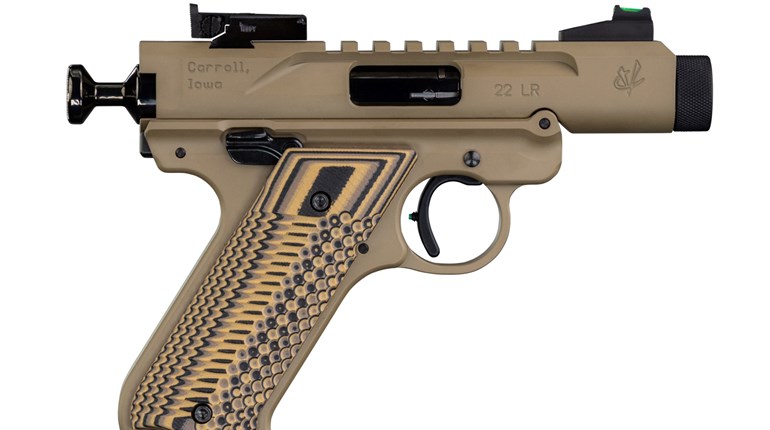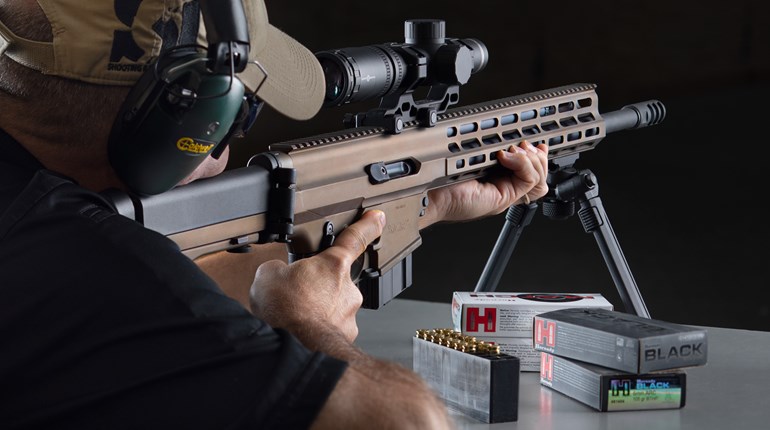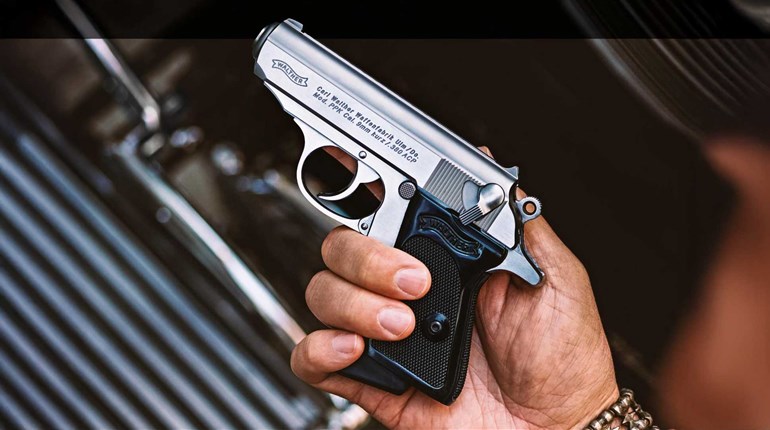
Beretta’s Bobcat is one of several pocket pistols that have as their most salient feature a tilt-up barrel that springs up by actuating a lever, thus allowing the chamber to be loaded or unloaded without racking the slide. With its small gripping surface, retracting the slide when the hammer is down is difficult for some people, so a pistol that can be made ready by inserting a magazine and loading the chamber directly can be a benefit. However, the oft-mentioned selling point that this feature makes the 21A suitable for those with arthritis in their hands is blunted, given the heavy DA trigger pull that presents a similar challenge to those so afflicted.
The frame and barrel are made from aluminum and steel forgings, respectively, with various steel parts hardened according to their use. Machining is well executed and, aside from a small mark on the hammer, there are no tool marks evident on my sample, even beneath the grips. The barrel is hand-fitted at the hinge pin and underlug to ensure a tight fit to the frame, which is important for accuracy. Beretta also goes the extra step to test-fire each pistol with three proof-pressure rounds to verify strength in addition to the more routine practice of function testing each Bobcat using consumer-available loads. The Covert model’s defining features are a newly available threaded barrel, black-oxide finish on steel parts and checkered walnut grip panels.
The Bobcat is direct-blowback-operated and because its tilting barrel allows you to clear the chamber, it lacks an extractor, relying instead on gas pressure to remove fired cases. Feeding is from a seven-round, single-column steel magazine with cut outs on both sides to verify load status. The magazine release is a steel button recessed into the left-side grip panel. The Bobcat can be fired without the magazine inserted and the slide has no provision to lock back.
There are three safety devices: a frame-mounted, thumb-activated lever that blocks the sear and locks the slide closed, a half-cock notch on the hammer and a spring-loaded firing pin that stays retracted in the breech face when the hammer is resting fully forward. Though the operating manual does not recommend carrying the Bobcat with a loaded chamber, it’s difficult to envision dropping this pistol on its muzzle with sufficient force for inertia to overcome the firing-pin spring and cause a discharge, or for a blow on the hammer to break the half-cock notch and allow it to travel forward with enough speed to ignite the primer.

With its beavertail backstrap and thick grip panels with subtle thumb rests on both sides, the Bobcat is quite comfortable in the hand. The magazine release, though unconventional, works well with right- or left-handed shooters who actuate it using a support-hand finger. Loading the magazine, however, is difficult—especially if wearing gloves—due to the abbreviated follower pull-down screw. The thumb safety was very stiff to actuate, but removing the grips and oiling the relevant parts resolved the problem.
The 21A’s 1980s design elements—namely a heavy trigger pull and minute fixed sights—detract from its otherwise good handling. The single-action pull has considerable creep and measured 6 pounds while the long, double-action pull exceeded my Lyman scale’s 12-pound limit, by as much as 1.5 pounds.
To determine ammo preference and validate point-of-aim, the Bobcat was shot with three loads and fired from a sandbag rest at 7 yards. My pistol showed a strong preference for Blaser, with five-shot groups averaging less than an inch. The Winchester M-22 typically shot smaller four-shot groups than its 2.69-inch average would indicate, but the first shot of the string was often an unexplained flyer printing higher than the others and spoiling an otherwise decent group.
In 150 rounds, I experienced six stovepipes and 12 failures to feed. The feeding problems tended to occur with the last round in the magazine, which could indicate an issue with spring-tension. Expect to experience a 50- to 100-round break-in with reliability improving with use. Ejection was occasionally quite weak, so it’s important to find ammo that works well in short barrels to avoid stovepipe stoppages given the lower back pressure created by its 2.9-inch barrel. Every high-velocity load tested, including Mini Mags, generated subsonic velocity and high-power loads were not necessary for proper function. The Bobcat’s double-action trigger proved handy by discharging three misfires with a second hammer strike, and rounds that did not ignite were easily cleared from the tip-up barrel if the chamber wasn’t fouled.

With its slightly longer barrel and ability to attach a suppressor, the Covert is likely the most reliable Bobcat because of a marginal increase in back pressure. Using an AAC Halcyon suppressor, the Bobcat still handles quite well without any sensation of being muzzle heavy. Moreover, the subsonic velocity generated by all loads made for a remarkably quiet range session and allows one to use the Halcyon in its shorter configuration with no noticeable increase in report.
The 21A Covert may not be perfect for self-defense and it’s a challenge to shoot accurately, but its metal and wood construction and comfortable grasp set it apart from the mishmash of polymer guns with a traditional appeal all its own.







































